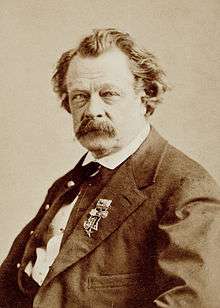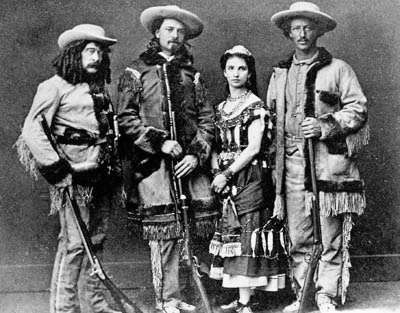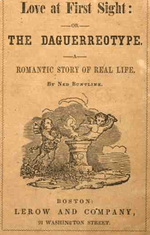Ned Buntline
| Ned Buntline | |
|---|---|
 | |
| Born |
Edward Zane Carroll Judson March 20, 1821[1] or 1823[2] Harpersfield, New York, US |
| Died |
July 18, 1886 (aged 63–65) Stamford, New York |
| Occupation | Dime novelist; author |
| Spouse(s) | Seberina Escudero, Annie Abigail Bennett, Marie Gardiner, Katharine Myers Aitchison, Lovanche L. Swart, Anna Fuller |
| Children | Mary Carrolita Briggs, Irene Elizabeth Brush, Alexander McClintock, Edwardina McCormick, Irene A. Judson, Edward Z. C. Judson, Jr. |
Edward Zane Carroll Judson Sr. (March 20, 1821[1] or 1823[2] – July 16, 1886), known as E. Z. C. Judson and by his pseudonym Ned Buntline, was an American publisher, journalist, writer, and publicist.
He reputedly commissioned the Colt firearms manufacturer to make a customized revolver, which came to be known as the Buntline Special, but no evidence of his involvement in its production has been found.
Early life
Judson was born in Harpersfield, New York,[1] near Stamford. He moved with his parents to Bethany, Pennsylvania, in 1826 and Philadelphia in 1834. His father, Levi Carroll Judson, was a lawyer[1] and wanted his son to be a clergyman.[3]
Naval and military service
In November 1834, Judson ran away to sea[1] as a cabin boy and the next year shipped on board a Navy vessel. A number of years later he rescued the crew of a boat that had been run down by a Fulton Ferry in New York's East River.[1] As a result, he received a commission as a midshipman in the Navy from President Martin Van Buren on February 10, 1838, and was assigned to the USS Levant.[1] He later served on the USS Constellation and the USS Boston.[1]
As a seaman, he served in the Seminole Wars, but he saw little combat. After four years at sea, he resigned. During the Civil War, he enlisted in the 1st New York Mounted Rifles and rose to the rank of sergeant before he was dishonorably discharged for drunkenness.[4]
Early literary efforts
Judson's first publication was an adventure story in The Knickerbocker in 1838. He spent several years in the East starting up newspapers and story papers, only to have most of them fail. An early success that helped launch his fame was The Mysteries and Miseries of New York, a gritty serial story of the Bowery and slums of New York City. He was an opinionated man and strongly advocated nativism and temperance; he also became a leader in the Know Nothing movement. In 1844, he adopted the pen name "Ned Buntline" (buntline is the nautical term for a rope at the bottom of a square sail).[4]
In 1845, his Cincinnati venture, Western Literary Journal and Monthly Magazine, was facing bankruptcy, and he fled from Ohio. In Eddyville, Kentucky, he collected a $600 bounty for single-handedly capturing two murderers. He moved to Nashville, Tennessee, and used the money to start a magazine, Ned Buntline's Own.[4]
Judson had a romance with the teenaged wife of Robert Porterfield in Nashville in 1846. On 14 March 1846, Porterfield challenged Judson to a duel, and Judson killed him. At his trial for murder, Judson was shot and wounded by Porterfield's brother and, during the chaos, escaped from custody. He was subsequently captured by a lynch mob and hanged from an awning but was rescued by friends. The Tennessee grand jury refused to indict him for murder.
In 1847, the Boston publisher and dime-novel author Maturin Murray Ballou paid Judson $100 to write The Black Avenger of the Spanish Main: or, The Fiend of Blood, a melodramatic and violent pirate novel. This was followed the same year with The Red Revenger; or, The Pirate King of the Floridas.[5][6] Buntline moved Ned Buntline's Own to New York City in 1848.[4]
Through his columns and his association with New York City's notorious gangs of the early 19th century, Buntline was one of the instigators of the Astor Place Riot, which left twenty-three people dead. He was fined $250 and sentenced to a year's imprisonment in September 1849.[7] After his release, he devoted himself to writing sensational stories for weekly newspapers, and his income from this source is said to have amounted to $20,000 a year. He was later involved in a nativist riot in St. Louis, while he was a member of the Know Nothing Party.
Although a heavy drinker, he traveled around the country giving lectures about temperance. He was an ardent Republican until the election of 1884, when he refused to support James G. Blaine. It was on one of his temperance lecture tours that he met William F. Cody ("Buffalo Bill").[4]
Wild Bill Hickok
Buntline was traveling through Nebraska when he heard that "Wild Bill" Hickok was in Fort McPherson. Buntline had read a popular article about Hickok and hoped to interview him and write a dime novel about him. He found Hickok in a saloon and rushed up to him, saying, "There's my man! I want you!" By this time in his life, Hickok had an aversion to surprises. He threatened Buntline with a gun and ordered him out of town in twenty-four hours. Buntline took him at his word and left the saloon. Still looking to get information on his subject, Buntline took to finding Hickok's friends. It is likely that this is how he first met Buffalo Bill.[8]
Buffalo Bill

Buntline took a train in 1869 from California to Nebraska, where he had been lecturing on the virtues of temperance. It was there that he met William Cody, who was with a group of men who had recently participated in a battle against the Sioux and Cheyenne.[9] Traveling with the gregarious Cody, Buntline became friends with him and later claimed that he created the nickname "Buffalo Bill" for the hero of his serial novel Buffalo Bill, the King of the Border Men, published in the New York Weekly beginning 23 December 1869.[10][11] Originally, Buntline was going to cast Cody as a sidekick of "Wild Bill" Hickok, but he found Cody's character more interesting than Hickok's. Buntline presented Cody as a "compendium of cliches"; however, this did not stop the New York playwright Frank Meader from using Buntline's novel as the basis of a play about Cody's life in 1872. In the same year, Buntline and James Gordon Bennett Jr. invited Cody to New York City, where Cody saw the play at the Bowery Theater. In December of that year, Buntline also wrote a Buffalo Bill play, Scouts of the Prairie, which was performed by Cody himself, Texas Jack Omohundro, the Italian ballerina Giuseppina Morlacchi, and Buntline.[12] For some time, six-year-old Carlos Montezuma also was featured in the show as "Atzeka, the Apache-child of Cochise", being the only genuine American Indian on stage, while his adoptive father, the Italian photographer Carlo Gentile, was hired to produce and sell promotional cartes de visite of the cast members.[13]
Cody at first was a reluctant actor but came to enjoy the spotlight. Scouts of the Prairie opened in Chicago in December 1872 and starred Cody. It was panned by critics but was a success nonetheless. It was performed to packed theaters across the country for years. Cody served as a scout for the Army in the summer; when campaigning stopped for the winter, he would head to the stage. Buntline's play served as training for Cody's later Wild West show.[12]
Later work

Buntline continued to write dime novels, but none was as successful as his earlier work. Later in life, he embellished his military career, claiming to have been chief of scouts in the Indian Wars, with the rank of colonel, and to have received twenty wounds in battle. He also used the following pseudonyms: Captain Hal Decker, Scout Jack Ford, and Edward Minturn. He settled into his home in Stamford, New York, where he died of congestive heart failure in 1886. He was once one of the wealthiest authors in America, but his wife had to sell his beloved home, "The Eagle's Nest," to pay his debts.
Buntline's novels may have had unintended consequences. Some avid readers became thrilled with the exploits of western outlaws and to them, the novels glamorized crime. The female bandits Little Britches and Cattle Annie, for instance, read dime novels which allegedly aroused their interest in the Doolin gang and may have propelled them into a youthful life of crime.[14]
The Buntline Special
Stuart N. Lake, in his largely fictionalized biography Wyatt Earp: Frontier Marshal (1931), wrote that Earp and four other well-known western lawmen—Bat Masterson, Bill Tilghman, Charlie Bassett, and Neal Brown—each received a Colt Single Action Army revolver as a gift from Buntline, in thanks for their help in contributing local color to his western yarns. The revolvers were said to be chambered in .45 Colt with 12-inch barrels, removable shoulder stocks, standard sights, and wooden grips into which the name Ned was ornately carved. These revolvers came to be known collectively as the Buntline Special. According to Lake, Earp kept his at the original 12-inch length, but the four other recipients of the revolvers cut their barrels down to 7½ inches. Modern researchers have not found any evidence in secondary sources or primary documents of the gun's existence prior to the publication of Lake's book.
Lake expended much effort trying to track these guns through the Colt company, Masterson, and Earp's contacts in Alaska. Researchers have not found any record of an order received by Colt and Buntline's alleged connection with Earp has been largely discredited by William B. Shillinberg,[15] who presented a detailed case to confute the Buntline Special legend. There is also no evidence that Buntline wrote about the occasion although Buntline wrote about everything.
Massad Ayoob, in Greatest Handguns of the World, stated that "historians debate whether Wyatt Earp owned a 'Buntline Special' (author is inclined to believe that he did), but Colt manufactured many in the latter half of the 20th Century." [16]
Portrayals in popular culture
The portly comedic character actor Richard Eliot (who wondered, "Why don't you kiss her instead of talking her to death?" in It's a Wonderful Life) played "Major Ned Buntline" in the 1935 film Annie Oakley with Barbara Stanwyck in the title role.
Academy Award Winning actor, Thomas Mitchell, played Ned Buntline in the 1944 film "Buffalo Bill", which also starred Joel McCrae and Maureen O'Hara.
C. Lindsay Workman played the role of Buntline in the ABC/Warner Brothers western television series Colt .45, in the 1959 episode entitled "A Legend of Buffalo Bill," with Britt Lomond as Cody. In this episode the series character Christopher Colt, portrayed by Wayde Preston, while investigating a series of raids on the railroad, meets Cody, who offers to sell Colt .45 pistols. The episode falsely implies that Colt gave Cody his nickname of "Buffalo Bill.[17]
From 1955 to 1958, Lloyd Corrigan played Buntline in several episodes of the ABC western series The Life and Legend of Wyatt Earp, starring Hugh O'Brian.[18]
Burt Lancaster played Buntline (referred to as "The Legend Maker") in Robert Altman's 1976 film Buffalo Bill and the Indians.[19]
Bibliography
- The Mysteries and Miseries of New York
- The Black Avenger of the Spanish Main: or, The Fiend of Blood (1847)
- The Red Revenger; or, The Pirate King of the Floridas (1847)
- Love at First Sight: or the Daguerreotype, a Romantic Story of Real Life (1847)
- Buffalo Bill, the King of the Border Men (1869)
- Scouts of the Prairie (play)
References
- 1 2 3 4 5 6 7 8 Johannsen, Albert (1950). The House of Beadle and Adams and Its Dime and Nickel Novels: The Story of a Vanished Literature. Norman: University of Oklahoma Press. pp. 56–62, 167–176.
- 1 2 Pond, Fred E. (1919). Life and Adventures of Ned Buntline. New York: Camdus Book Shop.
- ↑ Donaldson, Alfred Lee (1921). A History of the Adirondacks. New York: The Century. p. 118. Retrieved July 22, 2012.
- 1 2 3 4 5 McIver, Stuart B. (1998). "Hanging Mr Buntline". Dreamers, Schemers and Scalawags. Florida Chronicles, vol. 1. Pineapple Press. pp. 3–8. ISBN 978-1-56164-155-0.
- ↑ Rennie, Neil (2013). Treasure Neverland: Real and Imaginary Pirates. Oxford University Press. pp. 162–164.
- ↑ Buntline, Ned (1847).The Black Avenger of the Spanish Main: or, The Fiend of Blood. Boston: F. Gleason.
- ↑ Trager, James (2004). "1849". The New York Chronology: The Ultimate Compendium of Events, People, and Anecdotes from the Dutch to the Present. HarperCollins. p. 106. ISBN 978-0-06-074062-7.
- ↑ Gidmark, Jill B. (2001). Encyclopedia of American Literature of the Sea and Great Lakes. Greenwood Publishing Group. pp. 222–223. ISBN 978-0-313-30148-3.
- ↑ Streeby, Shelley (2002). American Sensations: Class, Empire, and the Production of Popular Culture (2 ed.). Berkeley: University of California Press. p. 3. ISBN 9780520223141. Retrieved 25 August 2015.
- ↑ DeForest, Tim (2004). Storytelling in the Pulps, Comics, and Radio: How Technology Changed Popular Fiction in America. McFarland. p. 17. ISBN 978-0-7864-1902-9.
- ↑ Streeby, Shelley (2002). American Sensations: Class, Empire, and the Production of Popular Culture (2 ed.). Berkeley: University of California Press. ISBN 9780520223141. Retrieved 25 August 2015.
- 1 2 Joy S. Kasson (2001). Buffalo Bill's Wild West: Celebrity, Memory, and Popular History. Macmillan. pp. 20–23. ISBN 978-0-8090-3244-0.
- ↑ Marino, Cesare (1998). The Remarkable Carlo Gentile: Italian Photographer of the American Frontier. Nevada City: Carl Mautz. pp. 43–47.
- ↑ "Cattle Annie & Little Britches". ranchdivaoutfitters.com. Retrieved December 26, 2012.
- ↑ Shillingberg, William B. (Summer 1976). "Wyatt Earp and the Buntline Special Myth". Kansas Historical Quarterly. 42 (2): 113–154.
- ↑ Massad Ayoob's Greatest Handguns of the World. Vol. 2. F. W. Media. Retrieved November 5, 2012.
- ↑ "Colt .45". ctva.biz. Retrieved December 22, 2012.
- ↑ "Full Cast and Crew for The Life and Legend of Wyatt Earp". Internet Movie Data Base. Retrieved January 23, 2013.
- ↑ "Buffalo Bill and the Indians, or Sitting Bull's History Lesson (1976)". Internet Movie Database. Retrieved 27 April 2014.
Further reading
- Monaghan, Jay (1952). The Great Rascal. Nabu Press. ISBN 978-1-179-63096-0.
- Streeby, Shelley (2002). American Sensations: Class, Empire, and the Production of Popular Culture ([Online-Ausg.] ed.). Berkeley [u.a.]: University of California Press. ISBN 978-0520229457.
External links
| Wikimedia Commons has media related to Ned Buntline. |
| Wikisource has original text related to this article: |
-
 "Judson, Edward Z. C.". Appletons' Cyclopædia of American Biography. 1892.
"Judson, Edward Z. C.". Appletons' Cyclopædia of American Biography. 1892. - Works by Ned Buntline at Project Gutenberg
- Works by or about Ned Buntline at Internet Archive
- Ned Buntline at Find a Grave
- The "Sensational, Hair-Raising, Blood-Curdling, Penny-Awful" American Life of Ned Buntline at The Readex Blog